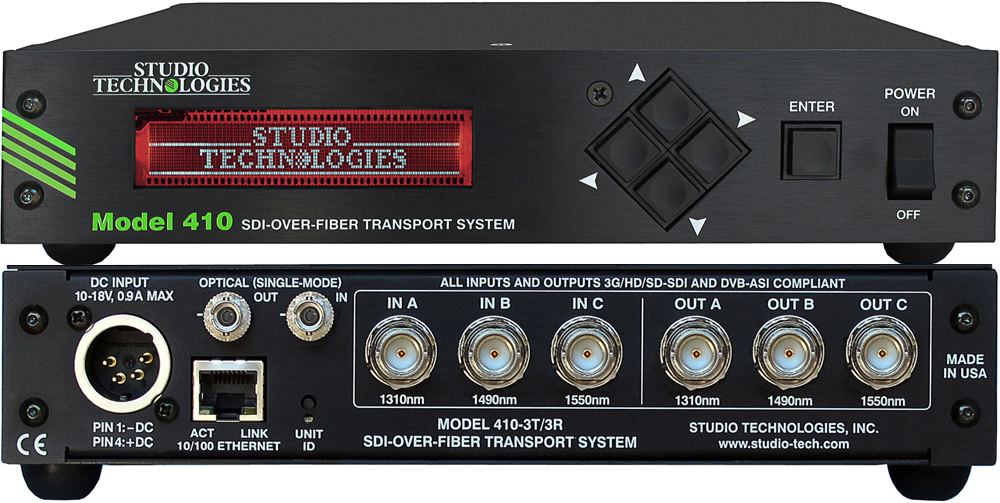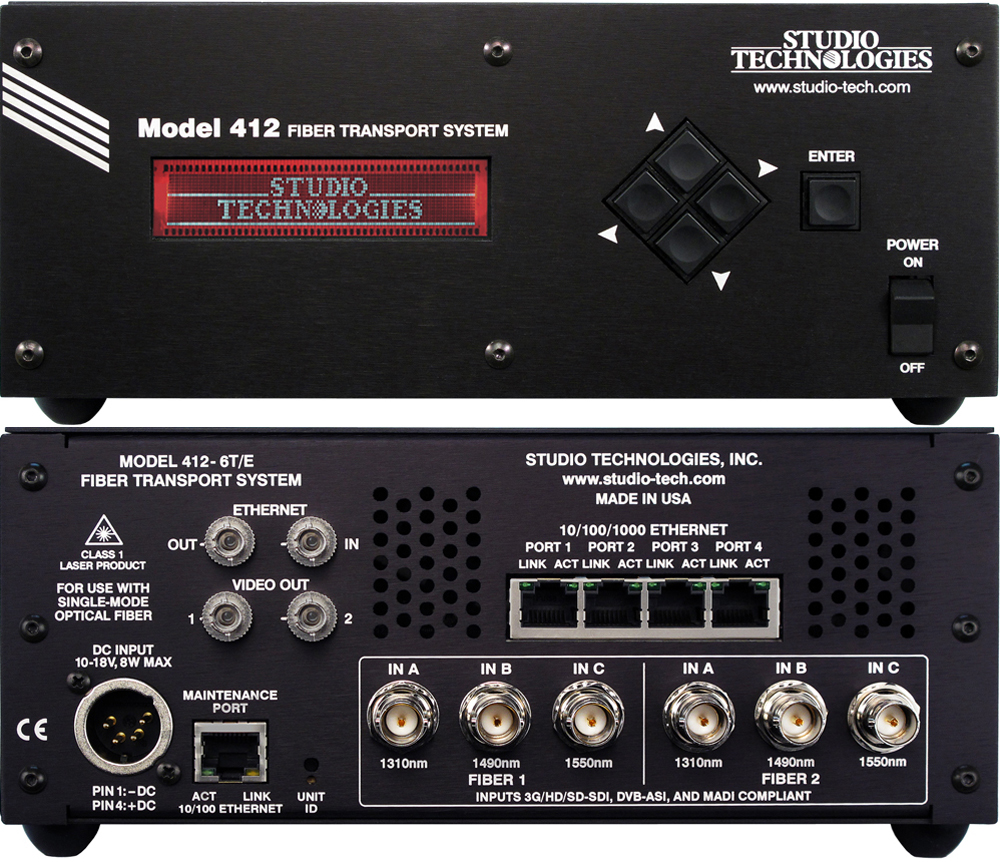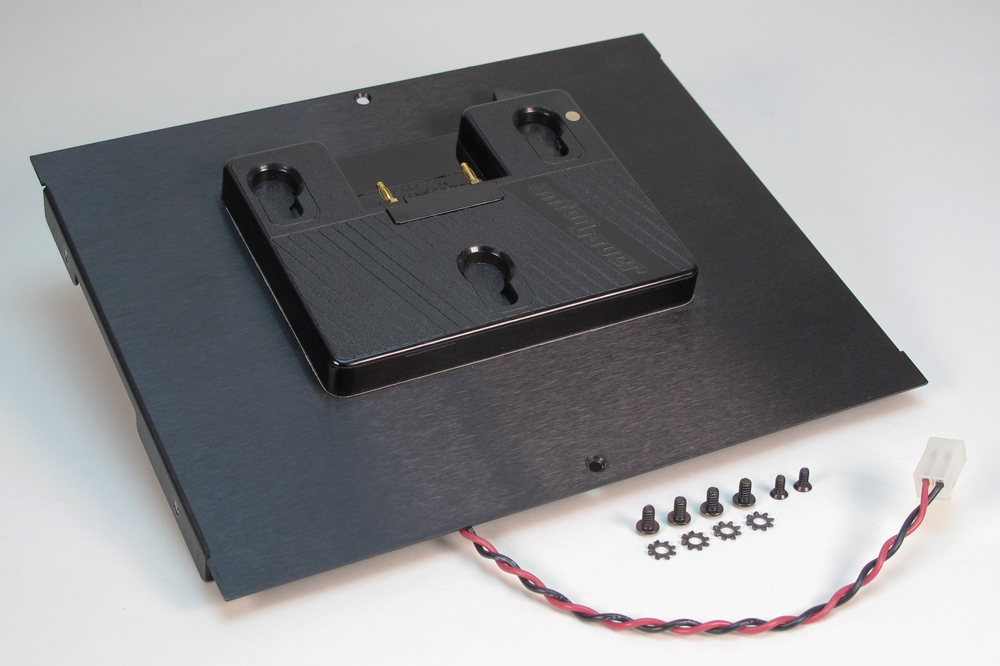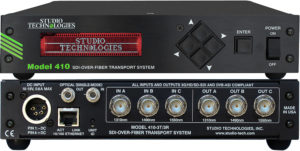The Model 410 SDI-Over-Fiber Transport System consists of half-rack "thrown-down" units that are factory configured from among three available choices. These configurations allow the needs of specific applications to be directly supported. The Model 410-3T is a 3-channel electrical-to-optical (E2O) unit. The Model 410-3R is a 3-channel optical-to-electrical (O2E) unit. For "transceiver" applications the Model 410-3T/3R provides three channels of electrical-to-optical (E2O) and three channels of optical-to-electrical (O2E) transport. Each unit's front panel features a day-/night-readable color backlit display, menu navigation buttons, status LEDs, and power on/off switch. Back panels include connections for DC power, ST and BNC connectors, and an RJ45 jack for the Ethernet interface.
Technology
The Model 410 uses a novel hardware implementation to transport three SDI signals over one single-mode optical fiber. The three SDI signals, at rates of up to 2.97 Gb/s, are transported over one fiber at wavelengths of 1310, 1490, and 1550 nm. In typical applications the launch power is such that signals can be transported over a minimum distance of 10 kilometers.
SDI input signals can be SD (270 Mb/s), HD (1.485 Gb/s), or 3G (2.97 Gb/s). 3G signals can be in either Level A or Level B format. The inputs also support video signals in the DVB-ASI (270 Mb/s) format. Each of the Model 410's SDI input channels is independent, allowing any combination of rates/formats to be transported.
Associated with each of the Model 410-3T's SDI inputs is a re-clocked and buffered loop-through output. These can be extremely useful, allowing a signal source to be routed to an input on a related piece of equipment. The SDI inputs on the Model 410-3T/3R are re-clocked but panel-space limitations prevent loop-through outputs from being provided.
The optical input on the Model 410-3R and Model 410-3T/3R units receive their signal via one single-mode fiber. The optical input is de-multiplexed into three optical channels, which are converted into electrical signals. Each of these SDI signals is then re-clocked and sent to SDI output drivers. With the Model 410-3R each SDI signal has two independent outputs. Space limitations dictated that the Model 410-3T/3R provides one SDI output per channel.
Operating Power
The Model 410 is powered using an external source of 10-18 volts DC that is connected via a broadcast-standard 4-pin XLR connector. Included with each unit is a compact 100-240 volt input/12 volt DC output power supply. An optional Model 410 cover assembly provides an Anton/Bauer® QR-Gold mount, allowing direct attachment of a broadcast-standard rechargeable battery. With the Model 410's modest energy requirement one battery can support operation for many, many hours.
Remote Monitoring and Configuration
The Model 410 has an embedded web server that allows the user to monitor system status through any web-enabled device such as a personal computer or smartphone. System status can also be communicated using SNMP, making it possble to integrate the unit's monitoring information into a networked alarm and control software application.
The Model 410's status screen lets a user or supervisor check the status of SDI input and output channels, signal rate, and whether the optical transmitters are enabled. The optical output power of each electrical-to-optical (E2O) channel is reported directly in dBm. The optical receive power (in dBm) of an optical-to-electrical (O2E) channel is also displayed. This is a particularly useful feature for remote system troubleshooting.
The embedded web server also provides a configuration menu, allowing a variety of monitoring parameters to be set. These include enabling alarms for loss of SDI inputs and outputs, low optical transmit and receive levels, and excessive temperature. Additional menu screens provide access to SNMP, network IP address, and front-panel display configurations. Advanced features include the ability to remotely update the Model 410's system firmware via the Ethernet connection.
Simple Installation
While the Ethernet-accessed monitoring and configuration functions enhance the utility of the Model 410 they are not necessary for basic SDI-over-fiber transport operation. Model 410 units will deliver reliable, high-quality performance with no other user actions outside of making SDI-over-coaxial cable, fiber, and power connections. All back-panel connectors are clearly labeled for simple, fast, and intuitive use. And the front-panel display provides direct access to the unit's most important status information.
The Model 410 is housed in a small, rugged, and lightweight aluminum enclosure that is designed to be "road tough." It can be used in this manner as a standalone portable unit for "throw-down" applications. Three rack-mount options are also available allowing one or two units to be mounted in one space (1U) of a standard 19-inch rack enclosure or one unit to be mounted in a special 10.5-inch rack.




















